Chavis Park and the No. 2 Special Three Abreast
Having lived in Raleigh for about ten years now, I feel sheepish to admit that my first visit to Chavis Park occurred about a week ago. Originally conceived as part of the Works Progress Administration, the Park opened in 1937 during segregation for Raleigh’s African American citizens. Named after John Chavis, a prominent black preacher and teacher alive in the late 18th and early 19th centuries, the Park provided a destination spot for black families from all over the state.
Easily accessible from Martin Luther King Blvd., the 37-acre park is equipped with a swimming pool for the summer, tennis courts, baseball diamonds, picnic areas, a playground, expanses of fields for soccer and other sports, and of course, the original Chavis Park Carousel.
Officially referred to as the “No. 2, Special Three Abreast, Allan Herschell Carousel,†the Chavis Park Carousel stands as one of Raleigh’s two Carousels registered with the National Carousel Association. Created by the Allan Herschell Company of North Tonawanda, New York, the Chavis Park Carousel was built sometime between 1916 and 1925 and installed at its current location in Chavis Park on July 2, 1937.
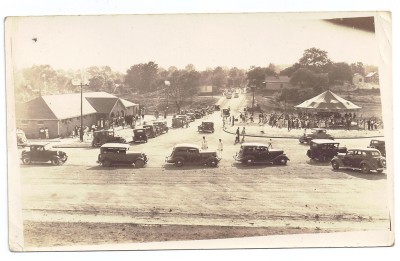
Photo of Chavis Park and the Carousel (before the wooden housing) from the late 1930s, with a view of the bathhouse on the left. Photo used with permission from, and thanks to: SPERNA Preservation and History Education Program and Lemuel Delaney
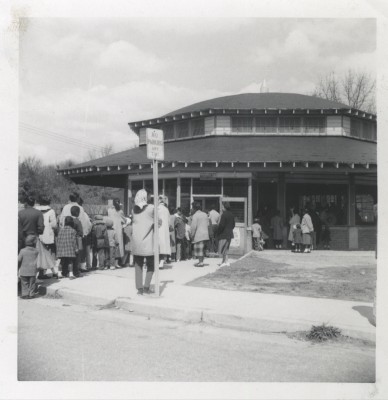
Photo of the Carousel from 1959, including the wooden housing that was installed in the early 1940s. Photo used with permission from, and thanks to: SPERNA Preservation and History Education Program, Raleigh City Museum, and James Autry
According to the Landmark Designation Report for the carousel, the Herschell Company catalogue describes this model as:
Thirty-six hand-carved horses (outer row studded with jewels) and two beautifully carved double-seat Chariots. Passenger capacity 48 persons. All horses are jumpers. Horse Hanger pipe and platform hanger pipe is encased in polished Brass. The Cornice, Shields and panel Picture Center are highly decorated works of art and are wired for 196 lights. Oil paintings and hand carvings combine with bright colors to produce a beautiful and practical machine. Standard equipment includes: Wurlitzer Military Band Organ with Drums and Cymbals…
In 1982 the Carousel was carefully restored to the tune of $145,000 at the supervision of a Raleigh-based carousel conservator, Rosa Ragan.
Since the 1970s, Chavis Park has grown to be a point of controversy for Raleigh citizens. The first round of renovations which occurred in the 70s came at the expense of several key elements to the Park. The Olympic-sized swimming pool was downgraded to a smaller pool and the adjoining bathhouse removed entirely.
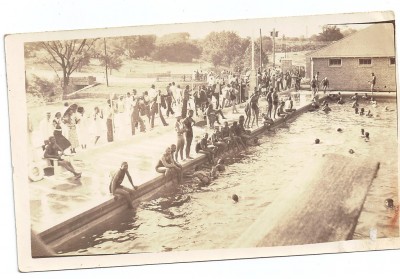
Photo of the Olympic-sized swimming pool and accompanying bathhouse. Photo used with permission from, and thanks to: SPERNA Preservation and History Education Program and Lemuel Delaney
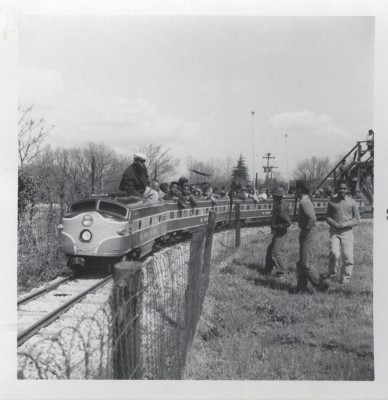
Photo of the miniature train which was removed in the 1970s renovation. A similar train still resides in Pullen Park. Photo used with permission from, and thanks to: SPERNA Preservation and History Education Program, Raleigh City Museum, and James Autry
Despite the City of Raleigh soliciting a Master Plan in 1994 for the second renovation of Chavis Park (prepared by Edward D. Stone Jr., and Associates from Durham, NC), a lack of funding and prioritization has caused multiple delays, much to the chagrin of the neighboring residents. According to the City of Raleigh website, the funding that is available is currently going toward a scientific study to assess the community’s desires regarding renovation of the park, and the proposed relocation of the Carousel to a more centralized position within the park.
While the City of Raleigh works to understand the desires of the surrounding community, local residents have spoken out time and again regarding the need for upgrades and better facilities, as well as leaving the Carousel in its original location. Currently, there are no restroom facilities or water fountains – seemingly standard amenities for a City park.
In a push to gain recognition for both the history of Raleigh and Chavis Park, while providing “an opportunity for public art to amplify citizens’ voices and increase dialogue,†the Raleigh Arts Commission featured “Cellphone Diaries†as part of the Block2 Street Video Series. Compiled by Assistant Professor Kofi Boone from the NC State College of Design, the digital video installation features 58 videos created by seventeen members of South and East Raleigh using smartphones to record their connection to Chavis Park.
While this installation was slated to end on January 14th, I did happen to see it still running on the 15th. Regardless, if you missed the installation, there is a test-map featuring some of the videos, which gives you an idea of the project.
Tickets to ride the Carousel are only $1, and the Carousel is open most of the summer. For specific hours, check the City of Raleigh website.
References and Further Reading:
- National Carousel Association
- NCSU College of Design
- Chavis Park Carousel Landmark Designation Report
- City of Raleigh – Chavis Park Carousel Renovation and Park Improvements
- News and Observer – Chavis Park a ghost of glory past
- City of Raleigh – Chavis Carousel
- Block Gallery – Block2 Previous Exhibitions

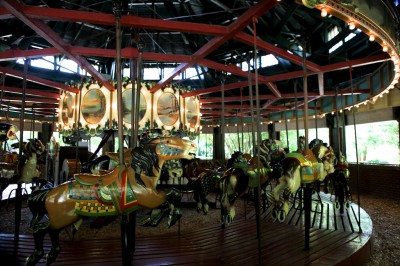
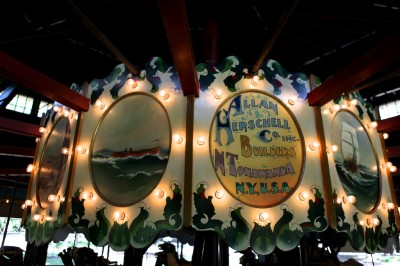
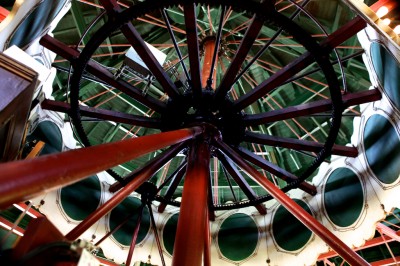
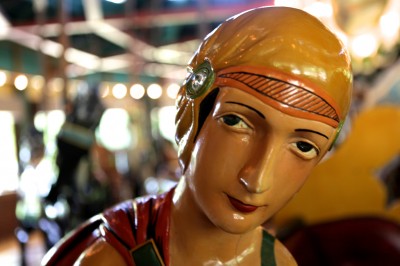

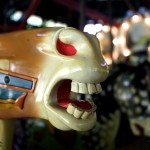
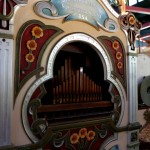
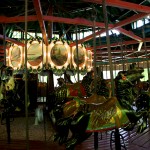
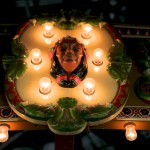
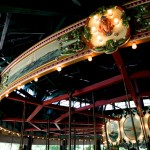
 Sign up for the Newsletter
Sign up for the Newsletter
01/24/2011
Great article on one of Raleigh treasures.. I have been lucky to find this and visit it a few times. If you are there, be sure to ask the operator to turn on the original organ for a true treat.
I was with a group of High School aged children with HOBY who spent the day volunteering and helping to clean the horses. What a great day as one of the city employees told us all about the history and info on the carousel.
I recommend that everyone who has an interest in Carousels go visit this treasure!
01/24/2011
Chavis Heights also has one of the nicest examples of public art in the City (IMHO). Mike Roig’s “Glimpses of a Promised Land”. Sitting at the bench, with the great view of the park and downtown, while the bird/planes that are part of the piece swirl above you. Great spot. Click here to see it, although these pics don’t do it justice.
http://www.raleighnc.gov/arts/content/CityMgrArts/Articles/Glimpses.html
01/24/2011
VaNC – I didn’t know the name or title of the piece, thanks for sharing the info. I agree it is one of the finest examples of public art in the city. Mine doesn’t quite do it justice either, but here’s a photo of it I took last year:
01/26/2011
Chavis Park is truly one of Raleigh’s treasures for many reasons.
As an insider of the gov division that oversees the park I can tell you 2 things:
1. There are bathrooms & water fountains at the Community Center – which is not far from the carousel.
2. Sadly much of the money allotted to the park goes to repairing the damage caused by the almost constant vandalism instead of being put towards upgrades.
However, the importance of the place is not lost on decision makers and public support and increased visitation are the keys to a bright future.
01/28/2011
Chavis Park thrived in its glory days because the community took pride in it and would never let it get into the shape it is in today. How did the glass get in the old pool? Why are the picnic shelters trashed year round? The city abandoned Chavis Park well after the community did. Potential funds for Chavis Park are used to run the Top Green community center a mere couple of blocks to the west, maintain the MLK gardens to the east and now the Walnut Creek Wetlands Center less than half a mile to the south.
The “uphill hike” to the community center’s bathroom is not ideal, but there are sweeping, gradual sidewalks for those who don’t want to take the stairs. The community center’s front desk is staffed, keeping vandalism and abuse of the facilities to a minimum. A free standing, unsupervised bathroom would only create more “community” complaints of neglect.
Also, the jogging/walking track behind the community center gets a lot of use by the community and was used by the St. Augs football team for practice. And the stream protection area is interesting, though somewhat negelected itself.
01/30/2011
Interesting article and nice photos of the carousel—but why no night-time photos? Isn’t this site called Goodnight, Raleigh!? I would have thought the old carousel would be especially dramatic at night. No?
02/04/2011
Tom – There are no night time photos of the carousel because it is not open during evening hours. We try to use only night photos when possible, but sometimes it’s more important to present a story than to adhere to the original idea behind the blog.
02/17/2012
I am very proud to see the changes being made to Chavis Park. My family moved to Chavis Heights Apts. in 1953 when I was the age of 6yrs.old.I was at Chavis Park everyday of the week.I am proud to be a member of the Chavis Heights Reunion Committee and I plan to be at the ground breaking cerimony on Feb.18th.I also worked at the concesson stand with Mr. Roy Hicks Sr.and his family.I also operated the Carousel and the minature Train at an early while growing up in Chavis Heights.
06/20/2013
For Chavis height complaint. To much traffic is coming in and out driving 15mph to 20mph speed bumps will stop some of the traffic
04/14/2018
I have noticed you don’t monetize your page, don’t waste your traffic,
you can earn extra cash every month because you’ve got hi quality content.
If you want to know how to make extra money, search
for: Ercannou’s essential adsense alternative
08/17/2018
I have noticed you don’t monetize your website, don’t waste your traffic, you can earn additional cash every month.
You can use the best adsense alternative for any type
of website (they approve all websites), for more info simply search in gooogle: boorfe’s tips monetize your website